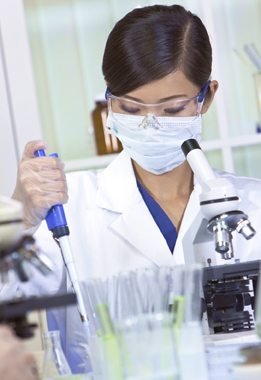Lesson 6
1. Lesson 6
1.1. Discover
Module 7: Exponents and Logarithms
Discover

iStockphoto /Thinkstock
In this activity you will determine the time when the bacteria reach a certain population using the equation ![]() of the laws of logarithms.
of the laws of logarithms.
Try This 1
Suppose that you begin with a single E. coli bacterium at time 0, and the conditions are appropriate for the bacteria to double in population every 20 min. This growth can be modelled using the equation ![]()
-
- Create a table that shows the number of bacteria at 20-min intervals for 5 h. Your table might start out like this one.
Time (in min) Number of Bacteria 0 20 40 - Use your table to estimate when there would be 10 000 bacteria.
- Create a table that shows the number of bacteria at 20-min intervals for 5 h. Your table might start out like this one.
-
- Follow the steps in the following table to algebraically determine an approximate time when there would be 10 000 bacteria. Make the assumption that the equation
 can be used to find an approximate time where there would be 10 000 bacteria.
can be used to find an approximate time where there would be 10 000 bacteria.
Write the equation. 
Substitute the known values for P and P0. 
Take the logarithm of both sides of the equation. 
Use the power law of logarithms, logb (Mn) = n logb M, to “bring down” the exponent 
Divide both sides of the equation by log 2. Multiply both sides of the equation by 20. Determine a decimal approximation of t. - How does the time you determined in 2.a. compare to your estimate from 1.b.?
- Follow the steps in the following table to algebraically determine an approximate time when there would be 10 000 bacteria. Make the assumption that the equation
![]() Save your responses in your course folder.
Save your responses in your course folder.
Share 1
With a partner or group, discuss the following based on your responses in Try This 1.
- Explain why the power law of logarithms is necessary to solve many exponential equations.
- How accurate do you expect the prediction you made in question 2.a. to be? Explain why.
![]() If required, save a summary of your discussion in your course folder.
If required, save a summary of your discussion in your course folder.

© Joe Gough/39773088/Fotolia
Most types of E. coli are harmless, or even helpful, to people. However, some strains of E. coli can cause food poisoning. One of the most common sources of these pathogenic E. coli is in undercooked ground beef. This is one reason why meat producers suggest cooking hamburger to 71°C before eating it.